The building of the Unbelievable
Every two years, Venice explodes in art. Even more art than its usual visual treat, that is, with the opening of Biennale, when every decaying palazzo is turned into a gallery, every house overlooking the Grand Canal has a blue man on a balcony or a huge hand holding up its wall.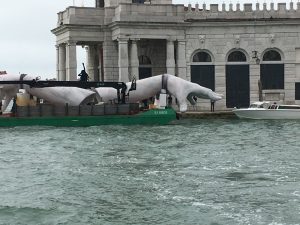
I hadn’t intended to come for it, any more than I intended to go to Japan a few years ago right at the height of cherry blossom season. If I’d had a choice, in fact, I might have avoided this, since the crowds are beyond ridiculous, edging into the daunting. But when I read an article in the Guardian about a new Damian Hirst…show? Exhibition? Installation? I decided I had to go.
Understand, I’m not a huge fan of modern art in general, and I draw the line long before dead calves in formaldehyde. But this one sounded unmissable.
Here’s what the Guardian said about it:
Inside, in perfect Discovery Channel pastiche, the tale is told of a freed slave named Cif Amotan II (solve that anagram)*, who accumulated an immense fortune which he spent on the sunken treasures divers are now dredging up on the screen before you. This is quite obviously hokum. One glimpse of the synthetic blue coral, or the Versace bling of the golden head gingerly dislodged from the sea floor, should give the game away, even before you see the amazing “hoard”. But then again, these are in a true sense buried treasures: buried and then rediscovered for the sake of this footage. The joke is already more subtle than many of the objects; this is art for a post-truth world.
Adding in a second review:
The astounding thing is not the insider’s joke, nor even the breadth of the things: It is the combination of intricate detail and stonking, mind-blowing scale and quantity that makes this collection so beguiling. By the time you get to a room full of gold objects, including a majestic-looking cornucopia (horn of plenty) and a gold replica of one of the sculpted portraits of life in west Africa, you feel drugged with history and art.
What astounds is the scope of the world-building here, ending up with a universe so complete in all its details, it feels true. After all, what kind of artistic maniac would first make a vast set of sculptures, then cover some of them with sea life like barnacles and corals from the spiky to the tumor-like? Some of the sculptures have three versions: the “discovered” form, with growths and centuries of damage; the “cleaned” one; and a third to show how it must have looked before losing a limb or head to time.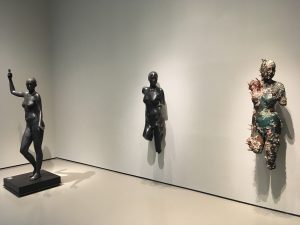
And who would then think to blow up some of the sculptures, going so far as to fill the entire center of a Venetian palazzo?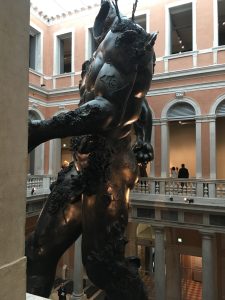
But that’s not all, folks. Loads of those finished sculptures–finished in the sense of coral etc attached, not in the sense of the clean original–were then carted onto a large recovery barge, with cranes and tanks and dozens of workers, many of whom are in diving gear, so the show could include dramatic Cousteau-esque videos of the “recovery” efforts.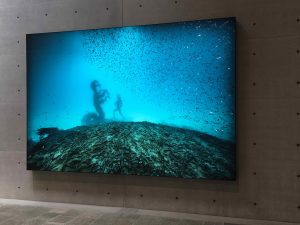
These madmen apparently lowered a whole slew of these enormous statues over the side, in order to show them coming up with water dripping off. I’m less certain about the close-up filming of the divers gently separating things from the sea floor, which could have been done by hiring some aquarium’s tank for a few days–but even then, the amount of work!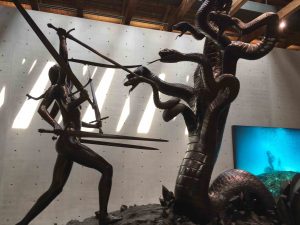
I do suspect that one of the sponsors is Disney: the joke skirts the very edge of tastelessness when not only Goofy,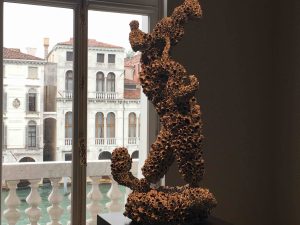 but Mowgli, Balu, and Mickey himself are among the treasure. That point in the exploration of the rooms is as dangerous as an unbelievable plot turn in a crime story. The willingness to suspend disbelief would shatter entirely were it not for the next rooms, bursting with spot-on imagery and yes, beauty.
but Mowgli, Balu, and Mickey himself are among the treasure. That point in the exploration of the rooms is as dangerous as an unbelievable plot turn in a crime story. The willingness to suspend disbelief would shatter entirely were it not for the next rooms, bursting with spot-on imagery and yes, beauty.
As an outsider to the world of modern art, I can’t even begin to analyze what I saw there. Few of the pieces could be from the actual hand of Damian Hirst: apparently his workshop for this included 250 craftsmen from all over the world. Much of the humor is more heavy-handed than deft. And many of the pieces are frankly derivative, if not outright plagiarized (accusations of cultural appropriation center around an African head, although the same protest could be lodged about half the pieces there, from Mayan calendar to Buddha.)
But that’s not the point. All the images are rooted elsewhere—the conceit being that this is a shipload of treasure collected by a first-century lover of world myth—but the genius lies not in one or ten or even a hundred of the pieces. The genius lies not in the idea of sticking bits of coral on a sculpture. The genius lies in doing it again and again and again. Then adding not one or two but three rooms of Roman coins and agricultural implements and weapons. Then making that video. And blowing up some of the original pieces to huge, HUGE pieces like the figure that greets you as you step into the Palazzo Grassi, filling the entire inner courtyard up to the ceiling in what looks to be solid, massive, bronze. And displaying a drop-dead gorgeous, gleaming silver sculpture of a woman warrior facing a many-headed snake in one setting, then placing a massively blown-up version of that same sculpture, complete with detritus of the sea, in the second of his warehouse settings on Venice’s Salute.
But my own personal favorite item? The piece I’d adore owning beyond the battling woman, past the malachite Medusa, more than the unicorn’s head? This: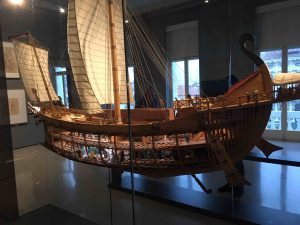
A stunningly perfect reproduction ship, complete with sculptures in the hold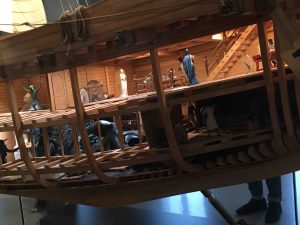
(and a heiroglyphed stele on deck.) Oh, what I would give for that.
Because that’s the story there, all potential and mystery. As I said earlier, the presence of those jarring Disney images makes me suspect funding, and possibly a movie. A Disneyland theme ride, maybe? And that anagram* mentioned earlier? The slave’s name when scrambled around reads, “I am a fiction” while the name of his treasure-laden ship—Apistos—translates as “unbelievable”.
The only thing missing here (so far…) is the novelization of Cif Amotan’s story.
Damian? I’m available.
Wow! Thank you for this great observation! Seems like a spectacle and your words are the next best thing to being there!
I am not much of a fan of modern “art” either, to put it mildly, but what you wrote about was amazing. All that effort and energy put into these unusual things. I had thought that the biennials were concentrated at the Venetian Arsenal. Your description of the installations spread around in various palazzos sounded cool.